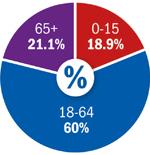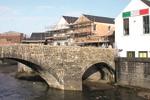Nestled between the bright lights of Swansea and Cardiff sits Bridgend, a traditional market town with a rich history of food, agriculture and farming. Until the first half of the 19th century the surrounding hills were sparsely populated, but the discovery of coal brought a massive influx of miners. The town is currently undergoing a redevelopment project hoping to welcome shoppers back into the town after years of missing out to the big cities.
‘It’s a nice area to work in, the people are fairly easy going and loyal,’ says The Eye Centre owner Nick Maydew. His independent practice, which has three branches across the borough, estimates 80% of its patients are NHS. He adds: ‘Lots of NHS patients means average dispensing value is relatively low. It can be difficult to up-sell to premium frames and lenses. We stock quite an extensive range including a few selective designers but due to the high numbers of patients receiving benefits it is the free range that is most popular.’

Despite a strong multiple presence, independent practices seem to be faring well in Bridgend. Maydew (pictured left) says: ‘Thankfully for us the multiples are generally seen, by my patients anyway, as retailers first and healthcare providers second whereas us independents are seen as healthcare providers first and retailers second. I have friends who work for the multiples and I understand they are really concentrating on getting the healthcare message across but in my opinion they can never compete in this field with hard working, experienced independents.’
Like many practices, The Eye Centre has benefitted both ‘professionally and financially’ from the government funded Welsh Eye Care Services (Wecs). Maydew says: ‘Wecs has been a huge fillip for us and I think it is a huge success. It means there is less pressure for us to sell as our income is
supplemented by this additional scheme. I as a practitioner thoroughly enjoy offering Wecs and it has meant I feel my skills and training are being properly utilised. It also makes the day less “routine” as we get to see patients with all sorts of ocular complaints.’
It is a similar story of Wecs popularity in the town’s Specsavers store. Bridgend’s retail director and Specsavers nationwide director of professional advancement Paul Morris says: ‘We have been seeing lots of clinical conditions instead of them going to hospitals or GPs. We have [an entire] clinic free, knowing people coming to us with a genuine need for primary eye care services will be treated.’
Wecs has seen a change in attitude of patient’s expectations of their optometrist. Morris adds: ‘Through Welsh government awareness, GP awareness and word of mouth, patients come to us rather than going to their GP. We are growing the practice on a traditional basis and clinical capabilities.’
Who’s in town?
Total: 7
Independents: 4
Multiples: 3
Average cost
Prices for an eye examination range from £21 to £30. The average cost is £25.

Population - see pie chart
Bridgend County Borough population: 139,178. (ONS 2014)
Community eye care
In the late 1990s, the Pears scheme was developed in Wales with the aim of making use of optometrists’ skills and equipment to triage patients with acute eye problems. The Welsh Eye Care Service and Eye Health Examination Wales, have now replaced Pears.
Health and affluence
- The average house price in Bridgend is £154,448 (Rightmove, 2016) compared with an average of £216,750 for England and Wales (Land Registry, 2016).
- NHS expenditure on vision problems in Bridgend per person is £94, compared with the UK average of £89 (RNIB Sight Loss Data Tool 2015).
- 6,410 patients live in Bridgend with early stage wet AMD and 470 with dry AMD (RNIB).
- There are about 1,520 people living in Bridgend who have cataract, 1,290 people with glaucoma and 9,400 with diabetes. Some 2840 patients have diabetic retinopathy (RNIB).
Fun facts
The biggest escape attempt made by German prisoners held in the UK during World War Two happened at Bridgend’s Island Farm. All were recaptured.

The town got its name from a bridge, pictured, built in 1425 to link the north and south banks of the river Ogmore.
Parts of David Lean’s film Lawrence of Arabia were filmed on the borough’s Merthyr Mawr sand dunes.
Habitation in Bridgend County Borough dates back 5,000 years to Neolithic times.
In medieval times, Pilgrims would stop off in Bridgend on their way to the shrine of St David’s in West Wales.
Bridgend has the UK’s largest Elvis festival.
